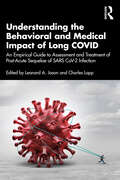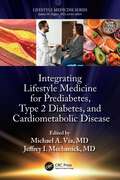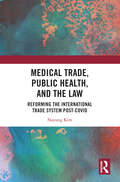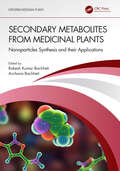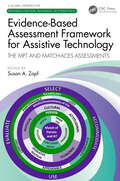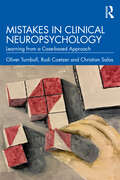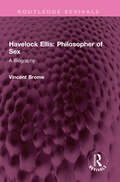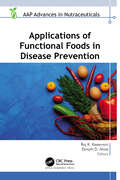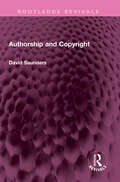- Table View
- List View
Understanding the Behavioral and Medical Impact of Long COVID: An Empirical Guide to Assessment and Treatment of Post-Acute Sequelae of SARS CoV-2 Infection
by Leonard A. Jason and Charles LappUnderstanding the Behavioral and Medical Impact of Long COVID serves to expand the research around the illness in order to enable health care researchers and practitioners to address the questions that are imperative to individuals suffering from this condition. Through its multi-faceted approach, the book puts forth a maturation of research and interventions that are theoretically sound, empirically valid, innovative, and creative in the Long COVID area. As a scholarly and scientific compilation of Long COVID symptoms and related disorders, this book offers unparalleled insight into the critical developments across medical areas treating this illness. It helps to fill the space that the pandemic had created for knowledge of the condition, and contributes to the emerging emphasis on translational research blending the social sciences and biological fields. By putting forth the most optimal medical care practices in the treatment of complex Long COVID symptoms, this practical anthology will serve as a guide for practicing clinicians in assessment as well as treatment. It will also benefit researchers aiming to gain more understanding of Long COVID through its discussion around the critical developments in other medical areas treating the condition, and paves the way for the collaboration and future research needed to best support the global effort to mitigate the effects of this illness. This book will be essential reading for academics, practitioners, and researchers. It will appeal to individuals engaging with the fields of medicine, public policy, psychology, and for researchers looking to gain clarity about our current understanding of Long COVID. It will further be of interest to public/government agencies, nonprofit organizations, and the general public wanting to gain more information about these ambiguous and evasive symptoms.
Lifestyle Medicine for Prediabetes, Type 2 Diabetes, and Cardiometabolic Disease (Lifestyle Medicine)
Lifestyle change is universally recommended for patients with type 2 diabetes and cardiometabolic disease, yet, the majority of clinical practice, educational programs, and clinical trials within these chronic disease spaces focus on medication use and procedures, with insufficient emphasis on lifestyle medicine. The concept of lifestyle medicine can serve as a countermeasure, acting through aspects of personal choice, natural and built environments, cultural traditions, and socioeconomic influences that affect the metabolic health of an individual. Integrating Lifestyle Medicine for Prediabetes, Type 2 Diabetes, and Cardiometabolic Disease provides clinical evidence for and a mechanistic understanding of the six pillars of lifestyle medicine. It guides the reader to identify opportunities for early intervention rather than focus on the diagnosis and treatment of the established disease. Interventions at earlier points have the potential to mitigate progression, prevent complications, reduce costs, and improve a patient’s overall health at all points in their lifetime. Key Features Provides mechanistic, epidemiological, and clinical understanding of all pillars of lifestyle medicine Presents information on mechanisms for lifestyle medicine in cardiometabolic disease Features a unique model that includes recognition of predisease and even pre-predisease with rationale for intervention Promotes evidence-based recommendations for all stages of cardiometabolic disease This volume in the Lifestyle Medicine series is an essential resource for clinicians and students, providing them with information to help them to prevent complications, reduce costs, and improve a patient’s overall health at all points in their lifetime.
Lifestyle Medicine for Prediabetes, Type 2 Diabetes, and Cardiometabolic Disease (Lifestyle Medicine)
by Michael A. Via Jeffrey I. MechanickLifestyle change is universally recommended for patients with type 2 diabetes and cardiometabolic disease, yet, the majority of clinical practice, educational programs, and clinical trials within these chronic disease spaces focus on medication use and procedures, with insufficient emphasis on lifestyle medicine. The concept of lifestyle medicine can serve as a countermeasure, acting through aspects of personal choice, natural and built environments, cultural traditions, and socioeconomic influences that affect the metabolic health of an individual. Integrating Lifestyle Medicine for Prediabetes, Type 2 Diabetes, and Cardiometabolic Disease provides clinical evidence for and a mechanistic understanding of the six pillars of lifestyle medicine. It guides the reader to identify opportunities for early intervention rather than focus on the diagnosis and treatment of the established disease. Interventions at earlier points have the potential to mitigate progression, prevent complications, reduce costs, and improve a patient’s overall health at all points in their lifetime. Key Features Provides mechanistic, epidemiological, and clinical understanding of all pillars of lifestyle medicine Presents information on mechanisms for lifestyle medicine in cardiometabolic disease Features a unique model that includes recognition of predisease and even pre-predisease with rationale for intervention Promotes evidence-based recommendations for all stages of cardiometabolic disease This volume in the Lifestyle Medicine series is an essential resource for clinicians and students, providing them with information to help them to prevent complications, reduce costs, and improve a patient’s overall health at all points in their lifetime.
Medical Trade, Public Health, and the Law: Reforming the International Trade System Post-Covid
by Nayung KimFaced with evolving trade and health dynamics, this book presents a historical, conceptual, and empirical examination of public health and medical procurement in international trade law at a time of emergency. The work argues that the current trade framework is outdated and must be redesigned to suit the new needs of the 21st century. It identifies critical problems within the current international trade system that prevents it from effectively responding to pandemics, as well as to the emerging digital economy. Based on the analysis, the study puts forward specific suggestions to upgrade the current trade rules framework to prepare for future international public health emergencies and further digitalization of health services. The book will be a valuable resource for academics, researchers and policy-makers working in the areas of International Trade Law, Public Health Law and Medical Law.
Medical Trade, Public Health, and the Law: Reforming the International Trade System Post-Covid
by Nayung KimFaced with evolving trade and health dynamics, this book presents a historical, conceptual, and empirical examination of public health and medical procurement in international trade law at a time of emergency. The work argues that the current trade framework is outdated and must be redesigned to suit the new needs of the 21st century. It identifies critical problems within the current international trade system that prevents it from effectively responding to pandemics, as well as to the emerging digital economy. Based on the analysis, the study puts forward specific suggestions to upgrade the current trade rules framework to prepare for future international public health emergencies and further digitalization of health services. The book will be a valuable resource for academics, researchers and policy-makers working in the areas of International Trade Law, Public Health Law and Medical Law.
Secondary Metabolites from Medicinal Plants: Nanoparticles Synthesis and their Applications (Exploring Medicinal Plants)
Medicinal plant-based synthesis of nanoparticles from various extracts is easy, safe, and eco-friendly. Medicinal and herbal plants are the natural source of medicines, mainly due to the presence of secondary metabolites, and have been used as medicine since ancient times. Secondary Metabolites from Medicinal Plants: Nanoparticles Synthesis and their Applications provides an overview on medicinal plant-based secondary metabolites and their use in the synthesis of different types of nanoparticles. It explores trends in growth, characterization, properties, and applications of nanoparticles from secondary metabolites including terpenoids, alkaloids, flavonoids, and phenolic compounds. It also explains the opportunities and future challenges of secondary metabolites in nanoparticle synthesis. Nanotechnology is a burgeoning research field, and due to its widespread application in almost every branch of science and technology, it creates many new opportunities. As part of the Exploring Medicinal Plants series, this book will be of huge benefit to plant scientists and researchers as well as graduates, postgraduates, researchers, and consultants working in the field of nanoparticles.
Secondary Metabolites from Medicinal Plants: Nanoparticles Synthesis and their Applications (Exploring Medicinal Plants)
by Rakesh Kumar Bachheti and Archana BachhetiMedicinal plant-based synthesis of nanoparticles from various extracts is easy, safe, and eco-friendly. Medicinal and herbal plants are the natural source of medicines, mainly due to the presence of secondary metabolites, and have been used as medicine since ancient times. Secondary Metabolites from Medicinal Plants: Nanoparticles Synthesis and their Applications provides an overview on medicinal plant-based secondary metabolites and their use in the synthesis of different types of nanoparticles. It explores trends in growth, characterization, properties, and applications of nanoparticles from secondary metabolites including terpenoids, alkaloids, flavonoids, and phenolic compounds. It also explains the opportunities and future challenges of secondary metabolites in nanoparticle synthesis. Nanotechnology is a burgeoning research field, and due to its widespread application in almost every branch of science and technology, it creates many new opportunities. As part of the Exploring Medicinal Plants series, this book will be of huge benefit to plant scientists and researchers as well as graduates, postgraduates, researchers, and consultants working in the field of nanoparticles.
Laboratory Manual for Strength and Conditioning
by Joshua Miller Paul Comfort John McMahonThe Laboratory Manual for Strength and Conditioning is a comprehensive text that provides students with meaningful lab experiences in the area of strength and conditioning and applied sport science. While each lab may be conducted in a sophisticated laboratory, there are opportunities to conduct the labs in a gym or field environment without costly equipment. It is a useful resource as students prepare for a career as a strength and conditioning coach, athletic trainer, physical therapist, or personal trainer. The Laboratory Manual for Strength and Conditioning is designed to be a practical guide for training students and professionals in the skills to be applied to strength and conditioning. The labs cover seven major aspects of strength and conditioning including speed, power, flexibility, agility, and fitness. The labs are practical and easy to follow with sample calculations, data tables, and worksheets to complete. Each includes suggested tasks/activities to apply the theory to real-world applications. Students will explore assessments of strength, aerobic capacity, power output, speed, change of direction, and muscular endurance, and gain understanding in the following areas: • Definitions of commonly used terms within the area of exploration, as well as commonly misused terms • Assessing performance (i.e., power, strength, speed, etc.) • Understanding laboratory- and field-based techniques for specific athlete populations • Describing optimal methods for testing in all aspects of physical performance • Evaluation of test results based upon sport and/or athlete normative data The lab manual is a valuable resource for strength coaches, personal trainers, kinesiology students, and educators at the undergraduate and beginning graduate-level programs and can be used in a graduate strength and conditioning course.
Laboratory Manual for Strength and Conditioning
by Joshua Miller Paul Comfort John McMahonThe Laboratory Manual for Strength and Conditioning is a comprehensive text that provides students with meaningful lab experiences in the area of strength and conditioning and applied sport science. While each lab may be conducted in a sophisticated laboratory, there are opportunities to conduct the labs in a gym or field environment without costly equipment. It is a useful resource as students prepare for a career as a strength and conditioning coach, athletic trainer, physical therapist, or personal trainer. The Laboratory Manual for Strength and Conditioning is designed to be a practical guide for training students and professionals in the skills to be applied to strength and conditioning. The labs cover seven major aspects of strength and conditioning including speed, power, flexibility, agility, and fitness. The labs are practical and easy to follow with sample calculations, data tables, and worksheets to complete. Each includes suggested tasks/activities to apply the theory to real-world applications. Students will explore assessments of strength, aerobic capacity, power output, speed, change of direction, and muscular endurance, and gain understanding in the following areas: • Definitions of commonly used terms within the area of exploration, as well as commonly misused terms • Assessing performance (i.e., power, strength, speed, etc.) • Understanding laboratory- and field-based techniques for specific athlete populations • Describing optimal methods for testing in all aspects of physical performance • Evaluation of test results based upon sport and/or athlete normative data The lab manual is a valuable resource for strength coaches, personal trainers, kinesiology students, and educators at the undergraduate and beginning graduate-level programs and can be used in a graduate strength and conditioning course.
Evidence-Based Assessment Framework for Assistive Technology: The MPT and MATCH-ACES Assessments
The primary focus of this book is to educate the reader on the Matching Person and Technology (MPT) model and assessment process that will guide the reader on consumer-centered assistive technology assessment and outcome measures designed to be used for individuals of all ages and all types of disabilities. The first section of the book introduces the MPT and Matching Assistive Technology and CHild (MATCH) assessment process and discusses key documents that align with the assessments including the International Classification of Functioning, Disability, and Health and the Occupational Therapy Framework III. The second section of the book focuses on the international emphasis of the MPT and MATCH assessments. At present, there are eight countries that are represented in this section. Each chapter includes information on the assessment translations (with access to copies if available or at least access on how to obtain copies). The authors discuss research on the use of the assessment within their country to support the assessment use. Lastly, a case scenario is discussed in each chapter to provide the reader with an example of how the assessment was used with an actual consumer. The last section of the book includes a focus on outcome studies in the areas of early childhood, education (primary secondary, and postsecondary), work, and functional independence. This section provides the reader insight into how to outline outcome measures within the MPT and MATCH process. There is an additional section on future works that includes a brief introduction to the Service Animal Adaptive Intervention Assessment. This book is targeted to the Assistive Technology Providers (ATP) and policymakers (health care, education, and rehabilitation engineering), the university student pursuing a career in these areas, and the consumer of assistive technology.
Evidence-Based Assessment Framework for Assistive Technology: The MPT and MATCH-ACES Assessments
by Susan A. ZapfThe primary focus of this book is to educate the reader on the Matching Person and Technology (MPT) model and assessment process that will guide the reader on consumer-centered assistive technology assessment and outcome measures designed to be used for individuals of all ages and all types of disabilities. The first section of the book introduces the MPT and Matching Assistive Technology and CHild (MATCH) assessment process and discusses key documents that align with the assessments including the International Classification of Functioning, Disability, and Health and the Occupational Therapy Framework III. The second section of the book focuses on the international emphasis of the MPT and MATCH assessments. At present, there are eight countries that are represented in this section. Each chapter includes information on the assessment translations (with access to copies if available or at least access on how to obtain copies). The authors discuss research on the use of the assessment within their country to support the assessment use. Lastly, a case scenario is discussed in each chapter to provide the reader with an example of how the assessment was used with an actual consumer. The last section of the book includes a focus on outcome studies in the areas of early childhood, education (primary secondary, and postsecondary), work, and functional independence. This section provides the reader insight into how to outline outcome measures within the MPT and MATCH process. There is an additional section on future works that includes a brief introduction to the Service Animal Adaptive Intervention Assessment. This book is targeted to the Assistive Technology Providers (ATP) and policymakers (health care, education, and rehabilitation engineering), the university student pursuing a career in these areas, and the consumer of assistive technology.
Mistakes in Clinical Neuropsychology: Learning from a Case-based Approach
by Oliver Turnbull Rudi Coetzer Christian SalasThis innovative book uses a case-based approach to discuss mistakes made in the practice of clinical neuropsychology to form a helpful tool in the training of early career clinicians. By allowing readers space for critical reflection during clinical practice, the book teaches competency in clinical neuropsychology, through the examination of errors as a central part of the learning process. The core of this book is a diverse series of mistakes, each embedded as a patient narrative. Each chapter is based around an example error, typically one that was made, by the authors, as early career clinicians. Early chapters focus on mistakes in neuropsychological assessment, and the diagnostic process. Later chapters focus on errors in rehabilitation and management. Each chapter is framed to reflect the situational context, for example the role of history, what constitutes normal performance, the way that complex tasks rely on foundational skills, or the treatment of patients with dysexecutive impairment. Towards the end of each chapter there is reflection on the nature of each error type. As such, each chapter follows the structure SEER (Situation, Example, Error, Reflection), helping the reader to imagine the situation around the mistake, its nature and relevance. The book especially emphasises small phrases of insight (axioms, or gnomes) that are widely used by experienced clinicians. This is valuable reading for students of clinical neuropsychology, occupational therapy and speech and language therapy as well as professionals in these fields such as neurologists, psychiatrists and other rehabilitation therapists. It is especially appropriate for those in the earlier stages of their career in clinical neuropsychology, or in related disciplines which involve the assessment and treatment of patients with neurological disorders that impair cognition or disrupt the regulation of emotion. However, experienced clinicians will also find it includes interesting insights to improve their practice.
Mistakes in Clinical Neuropsychology: Learning from a Case-based Approach
by Oliver Turnbull Rudi Coetzer Christian SalasThis innovative book uses a case-based approach to discuss mistakes made in the practice of clinical neuropsychology to form a helpful tool in the training of early career clinicians. By allowing readers space for critical reflection during clinical practice, the book teaches competency in clinical neuropsychology, through the examination of errors as a central part of the learning process. The core of this book is a diverse series of mistakes, each embedded as a patient narrative. Each chapter is based around an example error, typically one that was made, by the authors, as early career clinicians. Early chapters focus on mistakes in neuropsychological assessment, and the diagnostic process. Later chapters focus on errors in rehabilitation and management. Each chapter is framed to reflect the situational context, for example the role of history, what constitutes normal performance, the way that complex tasks rely on foundational skills, or the treatment of patients with dysexecutive impairment. Towards the end of each chapter there is reflection on the nature of each error type. As such, each chapter follows the structure SEER (Situation, Example, Error, Reflection), helping the reader to imagine the situation around the mistake, its nature and relevance. The book especially emphasises small phrases of insight (axioms, or gnomes) that are widely used by experienced clinicians. This is valuable reading for students of clinical neuropsychology, occupational therapy and speech and language therapy as well as professionals in these fields such as neurologists, psychiatrists and other rehabilitation therapists. It is especially appropriate for those in the earlier stages of their career in clinical neuropsychology, or in related disciplines which involve the assessment and treatment of patients with neurological disorders that impair cognition or disrupt the regulation of emotion. However, experienced clinicians will also find it includes interesting insights to improve their practice.
Havelock Ellis: A Biography (Routledge Revivals)
by Vincent BromeFirst published in 1979, Havelock Ellis is a biography of the philosopher of sex. Havelock Ellis trained first as a doctor but soon broke out of conventional medicine to shock Victorian England with his encyclopaedic seven-volume work, Studies in the Psychology of Sex. One of the last representatives of the days when man could attempt to embrace a universal view, he wrote more than fifty books covering such diverse subjects as medicine, eugenics, love, literature, criminal law, and above all, sex. These were strewn with findings on many major problems which still trouble us today and some of his solutions remain highly contemporary. His influence permeated many areas of social thinking, and his works played a considerable part in changing attitudes towards homosexuality, the relation between the sexes and sexual patterns of behaviour. The present biography re-assesses the main themes of Ellis’ work and throws new light on many aspects of his life from a wide variety of published and unpublished sources. It also provides a new account of his relationship with Freud from unpublished sources and an evaluation of their inter-related work. This book will be of interest to students of philosophy and psychology.
Havelock Ellis: A Biography (Routledge Revivals)
by Vincent BromeFirst published in 1979, Havelock Ellis is a biography of the philosopher of sex. Havelock Ellis trained first as a doctor but soon broke out of conventional medicine to shock Victorian England with his encyclopaedic seven-volume work, Studies in the Psychology of Sex. One of the last representatives of the days when man could attempt to embrace a universal view, he wrote more than fifty books covering such diverse subjects as medicine, eugenics, love, literature, criminal law, and above all, sex. These were strewn with findings on many major problems which still trouble us today and some of his solutions remain highly contemporary. His influence permeated many areas of social thinking, and his works played a considerable part in changing attitudes towards homosexuality, the relation between the sexes and sexual patterns of behaviour. The present biography re-assesses the main themes of Ellis’ work and throws new light on many aspects of his life from a wide variety of published and unpublished sources. It also provides a new account of his relationship with Freud from unpublished sources and an evaluation of their inter-related work. This book will be of interest to students of philosophy and psychology.
Creating Community Health: Interventions for Sustainable Healthcare
by Simon LennaneThis important book explores how community-based interventions can bridge the gap between health services and the voluntary sector to create more sustainable, healthy communities. Moving beyond a technologically driven, medicalised approach to healthcare, the book shows how social prescribing can provide a direct pathway to improving community health, embracing connection and challenging inequality. Written by a practicing GP, and illustrated through practical guidance, it demonstrates how this can offer a cost-effective, preventative means to improving health outcomes, enabling communities to be more resilient when confronting major issues such as climate change or pandemics. Building to a case study of how these methods were used in one town, Ross-on-Wye, the book will be invaluable reading for those working in healthcare, public health, local authorities, and the voluntary sector, as well as students and researchers interested in these areas.
Creating Community Health: Interventions for Sustainable Healthcare
by Simon LennaneThis important book explores how community-based interventions can bridge the gap between health services and the voluntary sector to create more sustainable, healthy communities. Moving beyond a technologically driven, medicalised approach to healthcare, the book shows how social prescribing can provide a direct pathway to improving community health, embracing connection and challenging inequality. Written by a practicing GP, and illustrated through practical guidance, it demonstrates how this can offer a cost-effective, preventative means to improving health outcomes, enabling communities to be more resilient when confronting major issues such as climate change or pandemics. Building to a case study of how these methods were used in one town, Ross-on-Wye, the book will be invaluable reading for those working in healthcare, public health, local authorities, and the voluntary sector, as well as students and researchers interested in these areas.
Teaching the World to Sleep: Psychological and Behavioural Assessment and Treatment Strategies for People with Sleeping Problems and Insomnia
by David R. LeeTeaching the World to Sleep provides a complete, science-based overview of sleep and sleep problems, from environmental, legal, and technological factors to assessment and treatment options. David R. Lee introduces the basic scientific concepts involved in sleep and provides a clear description of insomnias and the parasomnias. Teaching the World to Sleep discusses NICE-recommended Cognitive Behavioural Therapy for Insomnia (CBT-i) and the REST programme® and outlines considerations for at-risk groups, sleep and the law, and the application of dreams and dreaming in psychotherapy. This second edition includes a full update on research conducted since the publication of the first edition and includes new information on sleep in the legal setting, the rise of sleep apps and trackers and their impact on our sleep. Lee also considers neurodiversity, sleep in long Covid, rare and unusual sleep disorders and the delivery of treatment using the NHS-recommended stepped-care approach. Teaching the World to Sleep will be essential reading for psychotherapists, occupational therapists, and other professionals working with clients with sleep problems. It will also provide an accessible introduction to the science of sleep to readers looking to understand their own sleep problems.
Teaching the World to Sleep: Psychological and Behavioural Assessment and Treatment Strategies for People with Sleeping Problems and Insomnia
by David R. LeeTeaching the World to Sleep provides a complete, science-based overview of sleep and sleep problems, from environmental, legal, and technological factors to assessment and treatment options. David R. Lee introduces the basic scientific concepts involved in sleep and provides a clear description of insomnias and the parasomnias. Teaching the World to Sleep discusses NICE-recommended Cognitive Behavioural Therapy for Insomnia (CBT-i) and the REST programme® and outlines considerations for at-risk groups, sleep and the law, and the application of dreams and dreaming in psychotherapy. This second edition includes a full update on research conducted since the publication of the first edition and includes new information on sleep in the legal setting, the rise of sleep apps and trackers and their impact on our sleep. Lee also considers neurodiversity, sleep in long Covid, rare and unusual sleep disorders and the delivery of treatment using the NHS-recommended stepped-care approach. Teaching the World to Sleep will be essential reading for psychotherapists, occupational therapists, and other professionals working with clients with sleep problems. It will also provide an accessible introduction to the science of sleep to readers looking to understand their own sleep problems.
Applications of Functional Foods in Disease Prevention (AAP Advances in Nutraceuticals)
Functional food sources are growing in popularity because they are exceptionally nutritious and provide amazing medical advantages. They can help ensure against infection, prevent supplement deficiency, and advance appropriate health development and improvement. With illustrative case studies, this new volume explores the many roles of functional foods in the prevention and management of various diseases, including diabetes, autism spectrum disorder, weight loss and obesity, microbial infections, ulcers and other gastrointestinal diseases, mental disorders and brain health, cardiac health and cardiovascular diseases, osteoporosis and bone health, and more.
Applications of Functional Foods in Disease Prevention (AAP Advances in Nutraceuticals)
by Raj K. Keservani Eknath D. AhireFunctional food sources are growing in popularity because they are exceptionally nutritious and provide amazing medical advantages. They can help ensure against infection, prevent supplement deficiency, and advance appropriate health development and improvement. With illustrative case studies, this new volume explores the many roles of functional foods in the prevention and management of various diseases, including diabetes, autism spectrum disorder, weight loss and obesity, microbial infections, ulcers and other gastrointestinal diseases, mental disorders and brain health, cardiac health and cardiovascular diseases, osteoporosis and bone health, and more.
Authorship and Copyright (Routledge Revivals)
by David SaundersFirst published in 1992, Authorship and Copyright traces the history of constructions of authorship as a legal reality. It offers an alternative to the two mainstream interpretations that have traditionally been assigned to authorship: the Romantic dialectical ‘birth of the author’ or the language-based post-structuralist ‘death of the author.’ Saunders examines the shortcomings of both schemes by arguing that they impose an arbitrary philosophical direction on the history of authorship and the law of copyright. Saunders addresses the issues relating to copyright and the construction of authorship as a legal status. Combining information and polemic, the author explores such matters as the historical and theoretical relations of copyright and the droit moral, the aestheticization of the law and the juridification of aesthetics, and the argument that authorship as a legal reality is a historically contingent and variable arrangement that cannot be separated from its cultural and juridical context. This book will be of interest to students of law, literature and philosophy.
Authorship and Copyright (Routledge Revivals)
by David SaundersFirst published in 1992, Authorship and Copyright traces the history of constructions of authorship as a legal reality. It offers an alternative to the two mainstream interpretations that have traditionally been assigned to authorship: the Romantic dialectical ‘birth of the author’ or the language-based post-structuralist ‘death of the author.’ Saunders examines the shortcomings of both schemes by arguing that they impose an arbitrary philosophical direction on the history of authorship and the law of copyright. Saunders addresses the issues relating to copyright and the construction of authorship as a legal status. Combining information and polemic, the author explores such matters as the historical and theoretical relations of copyright and the droit moral, the aestheticization of the law and the juridification of aesthetics, and the argument that authorship as a legal reality is a historically contingent and variable arrangement that cannot be separated from its cultural and juridical context. This book will be of interest to students of law, literature and philosophy.
Kinaesthesia in the Psychology, Philosophy and Culture of Human Experience
by Roger SmithThis accessible book explores the nature and importance of kinaesthesia, considering how action, agency and movement intertwine and are fundamental in feeling embodied in the world. Bringing together psychological, philosophical and cultural perspectives, the book examines the subjective feeling of movement in a cross-disciplinary manner. It discusses kinaesthesia through the framework of embodied cognition and outlines how contemporary discussion in psychology and phenomenology can inform our understanding of everyday experience. The book also sketches a framework for full appreciation of the sense of movement in performance and cultural life, discussing how a sense of movement is central to one’s agency. It is composed in four ‘movements’, aiming to achieve a connected and original argument for why movement matters, an argument exemplified in dance. The first movement explains the science of kinaesthesia and the history of the concept to a discussion of current thought informed by phenomenology and embodied cognition, the second quiet movement reflects on the psychological and philosophical dimensions of the sense of movement, the third movement turns to the culture of movement in dance and walking, and the fourth rests with the pleasures of movement, and emphasizes the social dimensions of movement in gesture and agency. This wide-ranging book is a must-read for all those interested in the psychology of movement, embodied cognition, performance studies and the interaction between psychology and dance. It will also be of interest to students and practitioners of embodied movement and dance practice therapies.
Kinaesthesia in the Psychology, Philosophy and Culture of Human Experience
by Roger SmithThis accessible book explores the nature and importance of kinaesthesia, considering how action, agency and movement intertwine and are fundamental in feeling embodied in the world. Bringing together psychological, philosophical and cultural perspectives, the book examines the subjective feeling of movement in a cross-disciplinary manner. It discusses kinaesthesia through the framework of embodied cognition and outlines how contemporary discussion in psychology and phenomenology can inform our understanding of everyday experience. The book also sketches a framework for full appreciation of the sense of movement in performance and cultural life, discussing how a sense of movement is central to one’s agency. It is composed in four ‘movements’, aiming to achieve a connected and original argument for why movement matters, an argument exemplified in dance. The first movement explains the science of kinaesthesia and the history of the concept to a discussion of current thought informed by phenomenology and embodied cognition, the second quiet movement reflects on the psychological and philosophical dimensions of the sense of movement, the third movement turns to the culture of movement in dance and walking, and the fourth rests with the pleasures of movement, and emphasizes the social dimensions of movement in gesture and agency. This wide-ranging book is a must-read for all those interested in the psychology of movement, embodied cognition, performance studies and the interaction between psychology and dance. It will also be of interest to students and practitioners of embodied movement and dance practice therapies.
